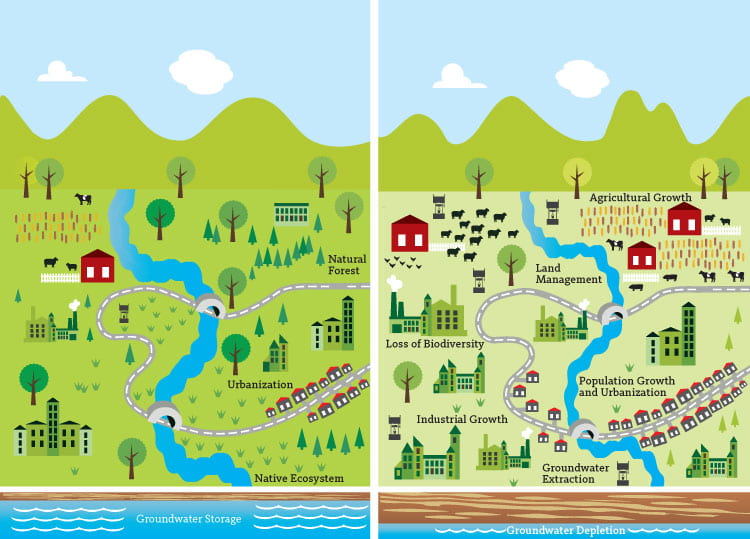Hot, dry and human-caused
UCI and other scientists say Californians must learn to live within the state’s new climate

California’s current extreme drought must be a lesson for managing water in a warmer, more densely populated world, say UCI and fellow drought experts writing in the journal Nature. Civil & environmental engineer Amir AghaKouchak, political scientist David Feldman and ecology & evolutionary biologist Travis Huxman call for greater recognition of the role of humans in causing and exacerbating water scarcity, which they dub “anthropogenic drought.”
The Golden State has a long history of successfully managing droughts. But strategies from the past century are now obsolete, they assert. The current drought, which began in 2012, is a harbinger of what’s to come. Engineering our way around periodic water shortages will no longer work in a hotter, drier world with ceaseless human demands on water supplies.
Our ever-increasing thirst for water coupled with poor management, aging infrastructure and worsening climate change is a recipe not just for wells run dry, but for ravaged forests, extinct wildlife and more droughts. Targeted research and public policies that move beyond a crisis response mentality are critically needed, the experts conclude.
Here are a few thoughts from the UCI authors:
What are some of the main points of the essay?
AghaKouchak: Elements of California’s current drought are archetypes of an anthropogenic drought that most of the world will grow into in coming decades, due to continuously increasing human water demands. While climate change impacts are real, anthropogenic drought should be recognized as an imminent challenge.
Feldman, director of the Water UCI initiative: As our climate likely changes and as cycles of drought continue with perhaps greater frequency, the “new normal” will require better and more consistently managing water demands and more widely introducing technologies and practices that encourage reuse and conservation of precious water supplies.
Huxman: The risk to society of ever-growing human demand for water combined with climate warming affects both ecosystems and goods and services provided by California’s landscapes. This compels us to thoughtfully prioritize how much water we should invest in “natural capital” versus other areas of use. The current approach is threatening the resilience of our landscapes.
You say a key element in managing future water supplies is investing in drought monitoring and prediction. Who could be helped by the ability to better predict droughts?
AghaKouchak: Accurate seasonal and yearly drought prediction remains the grand challenge for the science community. Scientists have also focused more on drought prediction over large spatial scales and paid little attention to localized conditions and impacts. Drought is often very local, and conditions for one water user may not equate to a shortage for a user elsewhere. Improperly managing demand can have substantial local effects, such as reduced crop production or rapid depletion of wells. The science community should focus on drought prediction systems that can address local and regional water management issues, in close collaboration with decision-makers.
You write that over 12 million trees have died statewide during the current drought, with cascading impacts on amphibians, birds and mammals. Key streams and wetlands, including hatcheries of steelhead trout and chinook salmon, are going dry. What needs to be done to protect our forests, fish and other wildlife?
Huxman: We’ve known for a long time that water diversion for human use – drinking water, power generation and farming – has come at the expense of biological diversity. What we’re trying to communicate is that the “response to crisis” approach has led to a lack of prioritization associated with decisions about the environment.
We’re letting crises decide for society what’s important about nature, rather than having the hard discussions about what society actually values in its surroundings. We’re letting low water flows impact species in one drought, then entering the next drought constrained by the impact of the last dry spell on those species. This pattern will lead to more and more impacts on biological diversity. While the focus on drought is in the public’s and decision-makers’ minds, we need to have those critical discussions about what we value in nature.
What are examples of good policy and poor policy related to the current California drought?
Feldman and Huxman: As we write in the article, the current drought has already led to the state’s most significant water initiative in half a century. The Sustainable Groundwater Management Act of 2014 tasks local agencies with assessing conditions in basins and developing local water management, allocation and adaptation plans. This is a major breakthrough for sustaining groundwater, but full implementation is expected to take decades..
In July, by contrast, the U.S. House of Representatives passed legislation that, if it becomes law, will offer some drought relief to California farmers and growers at the cost of protecting endangered fish. The legislation would take more water from the Sacramento-San Joaquin River Delta and from rivers. Such dramatic policy responses may have irreversible impacts, such as the extinction of native fish. It’s unlikely to be made law, though.
Feldman: Other good policy examples are encouraging conservation first – such as allowing consumers to compare their behavior and water use to their peers’ on bills. This is starting to yield dividends, as attested by reductions in urban water use statewide.
Bad policy is anything that assumes we can continue to divert water from places that have it to places that want it. This will only engender disputes and ill will.
***
Other authors are Martin Hoerling of the National Oceanic & Atmospheric Administration and Jay Lund of UC Davis. The article is an outgrowth of an April conference on drought policy convened by UCI and the American Geophysical Union.